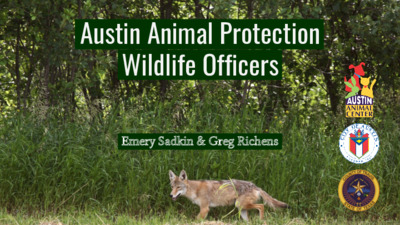Item 2 - Wildlife Update — original pdf
Backup

Austin Animal Protection Wildlife Officers Emery Sadkin & Greg Richens Guiding Philosophy The City of Austin does not remove or relocate healthy native wildlife. Guiding Philosophy Instead, we work with residents to humanely resolve conflict with wildlife using effective, evidence-based methods. Wildlife Ordinances – City of Austin § 3-2-4 - HUNTING AND TRAPPING WILD ANIMALS Except as provided in Subsection (B), a person may not knowingly shoot, kill, or hunt a wild animal; or use a steel-jawed spring trap or any other type of trap that could injure a trapped animal or person. § 9-6-7 - FIREARM DISCHARGE RESTRICTED Except as provided in Subsection (B), a person may not discharge a firearm in city limits. § 10-8-3 - FEEDING OF DEER PROHIBITED Except as provided in subsection (C), a person commits an offense if the person intentionally feeds deer or makes food available for consumption by deer on private or public property within the territorial limits of the city. Wildlife Officer Roles Investigate potential rabies exposures Identify non-native species for rehoming at the shelter • • • Assist sick and injured wildlife • Austin Wildlife Rescue • Assess wildlife behavior • Work with residents to address the root cause of conflict Suggest methods for humane exclusion (denning) • • Encourage the animal to move on its own • Offer tailored solutions • Utilize game cameras, site visits, yard audits, identification • Provide presentations, education, and outreach Travis County temporary contract for Wildlife Officer started January 2018 and became permanent in 2019. Wildlife Officer Stats 2022 • Average response time was .5 hours • Officers provided over 354 hours of outreach • Officers fielded 489 coyote calls in City of Austin from Jan – Nov 2022 • Officers fielded 624 wildlife calls in Travis County from Oct 2021- Sept 2022 • Of the 624 calls, 504 were escalated calls Emphasis on Education In-field Outreach ○ Hotline (311) ○ Email ○ Yard audits ○ Site visits ○ Neighborhood canvassing ○ Presentations ○ Events ○ Newsletters ○ Mailers ○ Community partnerships Educational Topics ● Animal behavior and ecology ● Hazing ● Identifying attractants ● Pet safety ● Wildlife exclusion / denning ● Spring / young wildlife ● Child safety ● Rabies prevention ● Coexistence City of Austin Coyote Policy • In November 2014, City Council approved a Coyote Management Policy • The goal is to help maintain a balance of public safety concerns and humane treatment for all animals • Work towards non-lethal management tools for a healthy ecosystem • Policy based on ecology and current research • Reshape behavior of the individual animal through hazing • Determine public safety threat Coyote Ecology Shapes Our Policy ● We have tried population control for the last 150 years ○ They don’t respond like most species (wolves) ● There is no apex predator besides humans ● We already kill 500,000 a year ~ approx. 1 per minute ● We would have to kill 75% of the total population consistently each year for 50 years to even see a dent ● They compensate for population reduction by: ○ Having larger litter size (up to 16 pups) ○ Pups will breed at earlier age ○ Pups have higher survival rate ● There is no season & no bag limit Why Are They Here? They got it good! ○ Reliable food sources ○ Habitat fragments ○ Few predators ○ Native Frequent Visitors? ● Unsecured trash or recycle ● Open compost piles ● Feeding pets and wildlife outdoors ● Feral cat colonies ● Dirty BBQ grills ● Fruit and nut trees ● Brush piles We create a habitat for them! Human Behavior Affects Coyote Behavior “HAZING” Encourage coyotes to avoid contact with people. ● Maintain eye contact ● Do not run or turn your back ● Be exaggerated, assertive, and persistent ● Use voice, arms, air horn, whistle, noisemaker, megaphone, hose, non-edible items thrown in direction of, repellant Addressing Root Cause of Conflict ● Wildlife Officers work with residents to address the root cause of a visitor through site visits, yard audits, and game cameras. ● Suggestions are tailored to the individual and are effective for the long- term. ○ Assess neighborhood trends and advise accordingly ● Officers can assist with humane, free, and effective exclusion practices to discourage denning. When to Call 311 Call 311 when you see wildlife that is: • Sick or injured • Displaying neurologic symptoms • Displaying activity that concerns you • Not responsive to assertive hazing Call 311 for tailored solutions for individual species • Skunks, opossums, raccoons, armadillos, coyotes, foxes, etc. Call 311 for Wildlife Officer assistance • Behavioral assessment, identification, outreach Questions? Thank you! Emery Sadkin – City of Austin emery.sadkin@austintexas.gov (512)-978-0514 Greg Richens – Travis County gregory.richens@austintexas.gov (512) 978-0513 Questions?